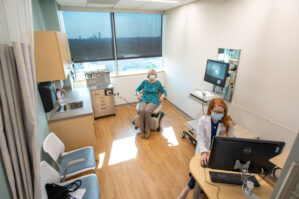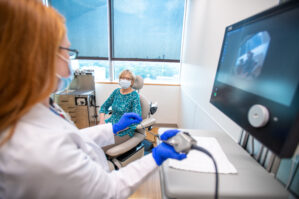
The Head and Neck Oncology Clinic at the University of Arkansas for Medical Sciences (UAMS) has moved to an impressive 5,000-square-foot space on the seventh floor of the Winthrop P. Rockefeller Cancer Institute. With a beautiful new waiting room overlooking the state Capitol, the clinic combines the best of aesthetics and efficiency to optimize the patient experience as well as the ability of the head-and-neck cancer team to meet their patients’ needs.
Outfitted with state-of-the-art technology, each of the 10 patient exam rooms serves as a consultation room, exam room, and—if needed—a procedure room. “We’re not playing musical chairs anymore,” said Mauricio Moreno, M.D., professor and director of the Head and Neck Surgery Division in the UAMS College of Medicine Department of Otolaryngology. “We won’t need to move the patient to another room to be scoped or to yet another room for a procedure—everything can be done in the same room.”

One reason for this is that each room is equipped with a state-of-the-art diagnostic tower. The tower includes a fiberoptic digital chip scope and monitor so that physicians can visualize a patient’s vocal cords, esophagus and other anatomy in the back of the throat during laryngoscopies and other diagnostic procedures. StreamConnect software is used, which allows the images to be reviewed by physicians, including anesthesiologists, in their workspaces. The software also allows physicians to save and store the images for later access, such as in multidisciplinary conferences, whereas before they had to document findings with written descriptions and individual pictures that were stored in the patient’s chart.
Samantha Rose, APRN, also said, “Now we have a video that we can review in our weekly head and neck tumor board meeting before a treatment plan.” The stored images help with patient surveillance by allowing doctors to better track and analyze changes that occur in a patient from month to month.
In addition, each of the new exam rooms is equipped with an exam chair that can convert to a patient bed, turning each room into a potential procedure room. As Moreno explained, “Instead of being a small patient consultation and examination room, now it’s a complete exam room with the capability of getting high-quality visual images stored into the chart and with the possibility of doing procedures in the same room.” The designated patient rooms are now also large enough to accommodate patients’ family members or caregivers, making it easier for patients to bring someone to appointments and allowing doctors to easily meet with the family members and patient together.

The number of rooms has increased from seven to 10. “Having bigger rooms is wonderful, but having more rooms has been the best part because we actually have room for more patients,” said Moreno. Two of the new rooms are speech pathology rooms, and a separate office for a social worker is also part of the new space. Previously, the speech pathologists and social worker were located away from the head and neck team. “By having a speech pathologist working with us in clinic, we basically can have streamlined communication with an important ancillary service,” Moreno said. Likewise, he said, having a social worker in the clinic space to help coordinate services is a big improvement.
The Head and Neck Oncology Clinic occupies the eastern half of the clinical space on the institute’s seventh floor while the Surgical Oncology Clinic occupies the other 5,000 square feet of space on the western side. The two clinics share a large conference room. Large windows along the eastern wall illuminate the clinic with natural light while frosted doors on the exam rooms and workspaces provide privacy. The outside view of the campus and the city skyline through the floor-to-ceiling glass walls on the seventh floor is stunning, providing another positive for doctors and patients alike.
“This is top of the line,” said Moreno. “The chairs, the towers, the view, the extra space, cutting-edge technology, and integration of the ancillary services – speech, diet and social work – into the clinic. It is a step further in our integrated model that will enhance patient care.“
